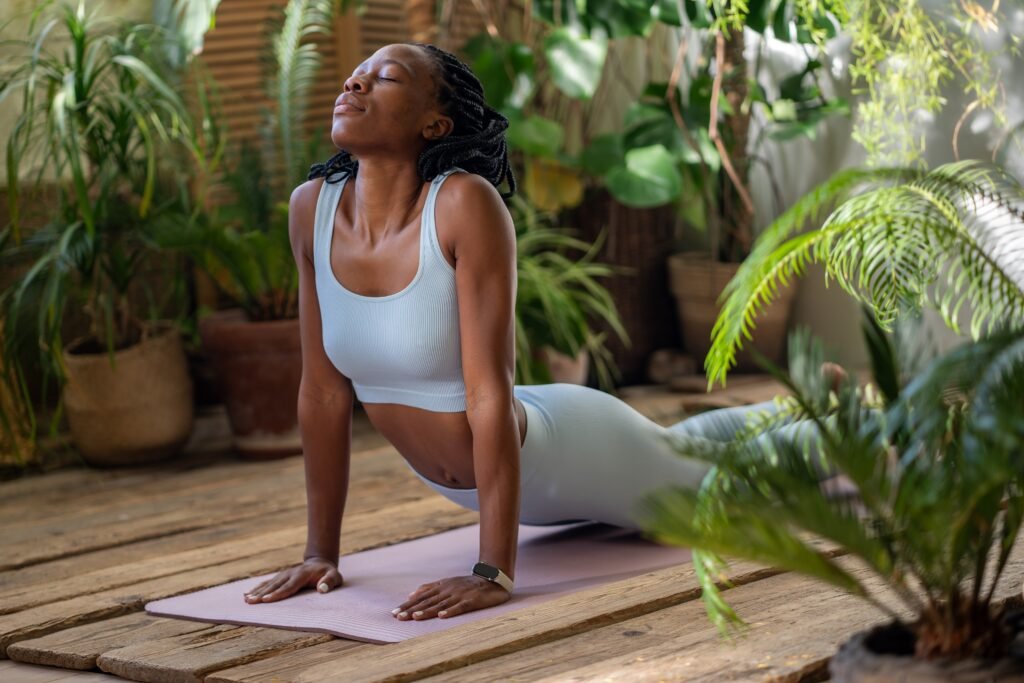Hatha yoga, often described as the foundation of all modern yoga practices, is a timeless discipline that harmonizes body, mind, and spirit. Known for its focus on physical postures, breath control, and meditation, Hatha yoga offers a gentle yet powerful path to wellness, accessible to beginners and seasoned practitioners alike. As yoga surges in popularity worldwide, Hatha remains a cornerstone, blending ancient wisdom with modern science to deliver profound physical, mental, and emotional benefits. In this comprehensive article for yoga-search.com, we’ll explore what Hatha yoga is, how it’s performed, its rich historical roots, and the extensive benefits backed by research, inviting you to discover why this practice continues to transform lives.
What Is Hatha Yoga?
Hatha yoga is a branch of yoga that emphasizes physical techniques to prepare the body and mind for spiritual growth. The term “Hatha” comes from Sanskrit, where ha means “sun” and tha means “moon,” symbolizing the balance of opposing energies—active and receptive, strength and flexibility, body and mind. Unlike more dynamic styles like Vinyasa or Ashtanga, Hatha yoga focuses on slower, deliberate movements, holding poses for several breaths, and integrating breathwork (pranayama) and meditation.
Hatha serves as an umbrella term for many physical yoga practices, making it versatile. A typical Hatha class might include a sequence of asanas (postures), pranayama, and a closing meditation or relaxation (savasana). It’s often recommended for beginners due to its accessible pace, but its depth appeals to advanced practitioners seeking alignment and mindfulness. Hatha’s goal is to align the body’s energy channels, fostering balance and preparing practitioners for deeper meditative states.
How Is Hatha Yoga Performed?
Hatha yoga classes vary depending on the teacher and tradition, but they generally follow a structured flow designed to balance effort and ease. Here’s a detailed look at how Hatha yoga is typically performed:
- Centering and Breathwork: Classes begin with a few minutes of seated meditation or gentle breathing exercises, such as Ujjayi (victorious breath) or Nadi Shodhana (alternate nostril breathing), to calm the mind and set an intention.
- Warm-Up: Gentle movements like Cat-Cow stretches, neck rolls, or Sun Salutations warm up the body, increasing blood flow and loosening joints.
- Asanas (Postures): The core of the practice involves a series of poses held for 5–10 breaths each. Common Hatha poses include:
- Standing Poses: Mountain Pose (Tadasana), Warrior I and II (Virabhadrasana I/II), Triangle Pose (Trikonasana).
- Balancing Poses: Tree Pose (Vrksasana), Eagle Pose (Garudasana).
- Seated Poses: Forward Fold (Paschimottanasana), Bound Angle Pose (Baddha Konasana).
- Backbends: Cobra Pose (Bhujangasana), Bridge Pose (Setu Bandhasana).
- Inversions: Downward-Facing Dog (Adho Mukha Svanasana), Shoulder Stand (Sarvangasana, if advanced). Each pose emphasizes proper alignment, breath awareness, and mindfulness, with modifications for different skill levels.
- Pranayama: Specific breathing techniques, like Kapalabhati (skull-shining breath) or Anuloma Viloma, are often integrated to enhance energy flow and focus.
- Relaxation and Meditation: Classes conclude with Savasana (Corpse Pose), a 5–10-minute relaxation to integrate the practice, followed by a brief meditation or chanting, such as “Om.”
Hatha classes typically last 60–90 minutes and are held in studios, gyms, or online, with props like blocks, straps, or blankets to aid alignment. Unlike flow-based styles, Hatha’s slower pace allows for deeper exploration of each pose, making it ideal for building strength, flexibility, and body awareness.
The Origins and History of Hatha Yoga
Hatha yoga’s roots trace back to ancient India, evolving over centuries as a spiritual and physical practice. Its history is rich and multifaceted:
- Vedic and Pre-Classical Roots (1500 BCE–500 BCE): Yoga’s earliest mentions appear in the Rigveda, with meditative practices aimed at connecting with the divine. The Upanishads (700–500 BCE) introduced concepts of breath and energy control, laying the groundwork for Hatha’s focus on prana (life force).
- Classical Yoga (200 CE): Patanjali’s Yoga Sutras formalized yoga as an eight-limbed path (Ashtanga), emphasizing meditation and ethics over physical postures. Hatha yoga later emerged to focus on the physical body as a tool for spiritual liberation.
- Medieval Hatha Yoga (9th–15th Century): Hatha yoga as we know it took shape with texts like the Hatha Yoga Pradipika (1350 CE) by Swami Svatmarama. This text, along with the Gheranda Samhita and Shiva Samhita, outlined physical practices—postures, breathwork, and cleansing techniques—to purify the body and balance energy. Hatha was developed by Nath yogis, who sought to prepare the body for intense meditation by mastering prana through asanas and bandhas (energy locks).
- Modern Hatha Yoga (19th–20th Century): In the late 19th century, Hatha yoga was revitalized by figures like Swami Vivekananda, who introduced yoga to the West, and T. Krishnamacharya, who blended Hatha with dynamic sequences, influencing modern styles like Iyengar and Ashtanga. The 20th century saw Hatha evolve into a wellness practice, with teachers like B.K.S. Iyengar emphasizing alignment and props, making it accessible globally.
- Today: Hatha yoga remains a foundational practice, taught in studios worldwide and adapted into hybrid forms like Hatha Flow. Its emphasis on balance and mindfulness resonates in our fast-paced, stress-filled world.
Hatha’s evolution reflects its adaptability, blending ancient spiritual goals with modern health needs, making it a timeless practice for all.
The Benefits of Hatha Yoga
Hatha yoga’s holistic approach yields extensive benefits, supported by scientific research and centuries of anecdotal evidence. Below are the key physical, mental, and emotional benefits:
Physical Benefits
- Improved Flexibility: Holding poses stretches muscles and connective tissues, increasing range of motion. A 2016 study in the International Journal of Yoga found that 12 weeks of Hatha yoga significantly improved flexibility in adults compared to a control group.
- Increased Strength: Poses like Warrior II and Plank build muscle strength, particularly in the core, legs, and arms. Research from 2015 showed Hatha yoga enhanced muscular strength in women after eight weeks.
- Better Posture and Alignment: Hatha’s focus on precise alignment corrects postural imbalances, reducing strain on the spine and joints. A 2020 study linked Hatha yoga to improved spinal health and reduced back pain.
- Enhanced Balance: Balancing poses like Tree Pose improve proprioception and stability, reducing fall risk, especially in older adults. A 2018 study found Hatha yoga improved balance in seniors after 12 weeks.
- Cardiovascular Health: Gentle Hatha sequences and pranayama lower blood pressure and heart rate. A 2021 meta-analysis in Complementary Therapies in Medicine found Hatha yoga reduced cardiovascular risk factors in adults with metabolic syndrome.
- Pain Relief: Hatha yoga alleviates chronic pain, particularly in the lower back and joints. A 2017 randomized controlled trial showed Hatha yoga reduced pain and improved function in patients with chronic low back pain.
Mental and Emotional Benefits
- Stress Reduction: Hatha’s slow pace and breathwork activate the parasympathetic nervous system, lowering cortisol levels. A 2018 study in Frontiers in Immunology found that Hatha yoga reduced stress markers in practitioners after 10 weeks.
- Improved Mental Clarity: Meditation and mindfulness in Hatha enhance focus and cognitive function. A 2020 study showed improved attention and memory in participants after a Hatha yoga program.
- Emotional Resilience: Hatha fosters emotional regulation by encouraging non-judgmental awareness of thoughts. A 2019 study in Mindfulness linked Hatha yoga to reduced anxiety and depression symptoms in adults.
- Better Sleep: The relaxation techniques in Hatha, like Savasana and pranayama, improve sleep quality. A 2020 randomized trial found Hatha yoga significantly enhanced sleep in university students after six weeks.
- Mood Enhancement: Hatha yoga boosts serotonin and endorphin levels, promoting a sense of well-being. A 2021 study in The Journal of Alternative and Complementary Medicine reported improved mood in participants after regular Hatha practice.
Spiritual Benefits
- Inner Connection: Hatha’s meditative focus fosters a sense of unity with oneself and the universe, aligning with its historical spiritual roots.
- Mindfulness and Presence: By emphasizing breath and body awareness, Hatha cultivates a state of “being in the moment,” enhancing spiritual growth.
- Energy Balance: Practices like pranayama and bandhas clear energy blockages, promoting vitality and a sense of inner peace, as described in traditional texts like the Hatha Yoga Pradipika.
Practical Tips for Starting Hatha Yoga
Ready to try Hatha yoga? Here are some tips to begin your journey:
- Find a Qualified Teacher: Look for certified instructors (e.g., Yoga Alliance RYT) who emphasize alignment and breathwork. Online platforms like Yoga International offer Hatha classes for all levels.
- Start with Basics: Attend beginner-friendly classes or workshops to learn foundational poses and breathing techniques.
- Use Props: Blocks, straps, and blankets help with alignment and make poses accessible, especially for beginners.
- Practice Consistently: Aim for 2–3 sessions per week, even if short (20–30 minutes), to build strength and flexibility.
- Listen to Your Body: Hatha emphasizes ease—avoid pushing into pain and modify poses as needed.
- Incorporate at Home: Practice simple sequences like Sun Salutations or try guided Hatha videos for convenience.
Conclusion
Hatha yoga is a transformative practice that bridges ancient wisdom with modern wellness, offering a path to balance, strength, and inner peace. From its origins in ancient India to its global popularity today, Hatha yoga remains a versatile and accessible discipline, blending physical postures, breathwork, and meditation to nurture body, mind, and spirit. Its benefits—improved flexibility, reduced stress, enhanced mental clarity, and spiritual growth—are backed by both tradition and science, making it a powerful tool for holistic health. Whether you’re stepping onto the mat for the first time or deepening an existing practice, Hatha yoga invites you to slow down, breathe deeply, and discover your inner potential. So, grab a mat, find a class, and let Hatha guide you to a more vibrant, balanced life.






Leave a Reply